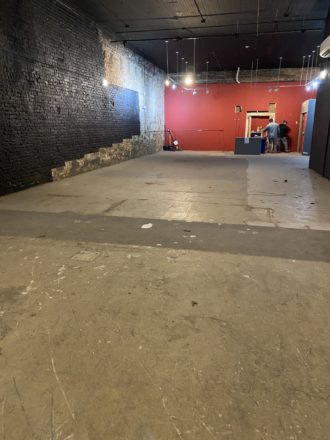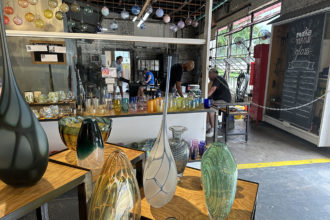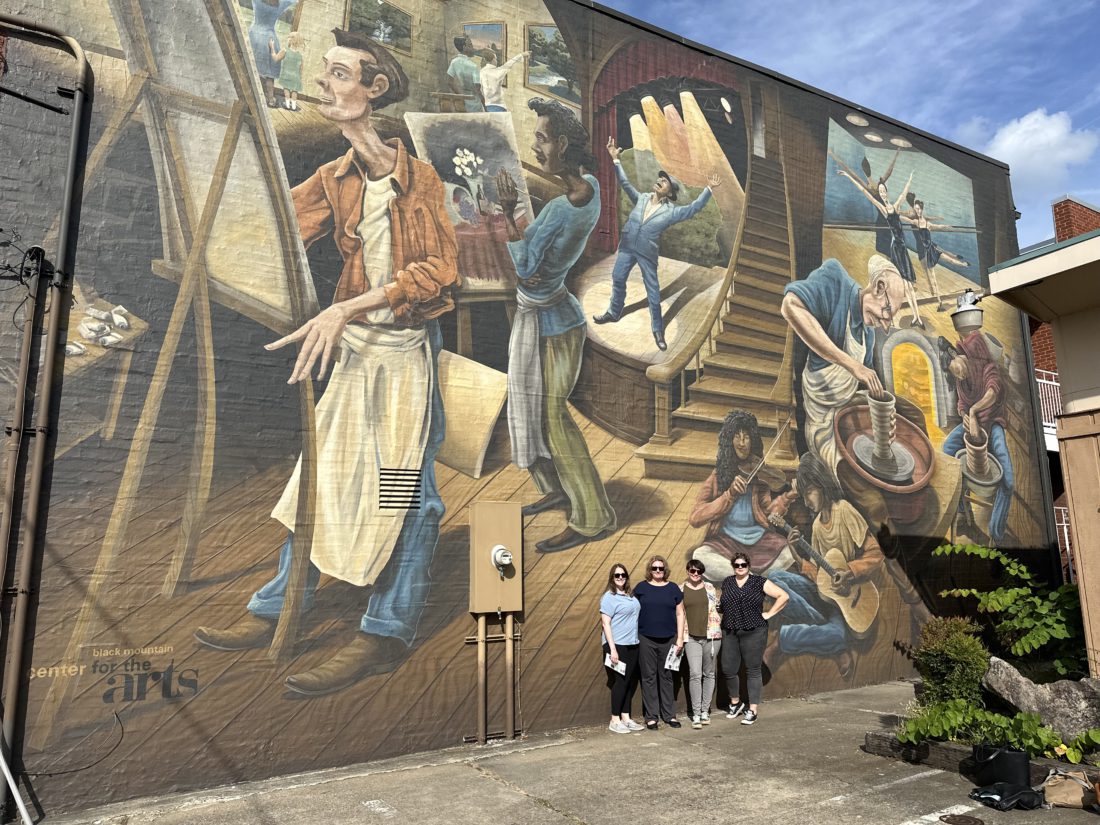ArtsAVL has come a long way during Katie Cornell’s tenure as executive director. Yet even more significant challenges and opportunities lie ahead as the fifth anniversary of her hiring approaches.
In early February, the designated arts agency for Buncombe County opened its survey to collect feedback from local artists and arts organizations about affordability and space challenges. The survey addresses what the ArtsAVL team sees as the top issue for area creators.
“This is what we’re hearing across the board: Artists are being pushed out. They can’t afford to live here anymore. They can’t afford to do their work here,” Cornell says. “And we’re hearing arts organizations are having a really hard time. Magnetic Theatre just lost their space. They’re having a hard time finding places for rehearsal and performance — not just their home base location. So, affordability is a huge issue.”
The study builds on Artspace’s 2018 Arts Market Study and looks at data from local arts professionals and businesses in the Asheville metro area (Buncombe, Haywood, Henderson and Madison counties). The Creative Spaces survey is open through Monday, March 11, and the more artists who take it, the more data ArtsAVL will have to advocate for local creatives.
Survey says
Cornell joined the organization in summer 2019, when it was then known as the Asheville Area Arts Council. She leads a team that currently includes Assistant Director Caroline Crupi, Development Director Rebecca Lynch and Communications Manager Ali McGhee. Their efforts center on helping local artists find the resources they need to thrive, yet meeting those needs has become increasingly difficult.
“There’s a superhigh barrier to entry here in Buncombe County, and it is not easy to be a working artist,” Cornell says.
She cites recent findings that the fair-market rent has gone up 78% in the last five years and notes that the 5-year-old Arts Market Study already identified affordability of space as a major issue before that increase.
“We’re looking to how we address these barriers to entry that are just growing higher and higher,” Cornell says. “A lot of our young, up-and-coming artists are leaving town. They can’t make it here. A lot of our established artists are moving out of the county or out of the state, so we’re superworried about that.”
The Creative Spaces report’s comprehensive findings will be released in May, in conjunction with ArtsAVL’s final town hall for the current fiscal year. The event will feature a panel discussion about different creative solutions to deal with cost-of-living issues.
“The city’s doing their affordable housing plan right now, and the county’s really focused on affordable housing, so we’re trying to find ways that we can be part of this discussion,” Cornell says.

In an effort to buoy the Creative Spaces report, ArtsAVL has partnered with students at Duke University who are looking at national case studies on what other communities are doing, both around the workspace and implementing the arts into affordable housing projects through solutions such as makerspaces.
“We see this as being the first step toward creating a cultural plan for Buncombe County,” Cornell says. “There has never been a cultural plan for Asheville or Buncombe County, which is kind of crazy considering how much arts and culture is in our community. [Arts organizations] are undertaking all these initiatives kind of blindfolded with no long-term plan, and everybody’s siloed doing their own thing.”
Cornell feels that with the amount of growth happening in Asheville, a cultural plan “is becoming necessary.” And with ArtsAVL entering the third and final year of it current strategic plan, she adds that having some kind of a cultural plan would be immensely helpful in helping decide ArtsAVL’s next moves.
Trifocals
With no designated staff for arts and culture at the City of Asheville or Buncombe County, ArtsAVL serves as, in Cornell’s words, “a voice for the arts at the table.” When Cornell took over as executive director in 2019, one of her goals was to help the community better understand the role of the local arts council. To achieve this, she’s developed three focus areas: advocacy, grant programs and outreach.
“We do a lot of reporting now to make it clear the impact of arts and culture, as well as how it’s being impacted, which was supervaluable during the [COVID-19] pandemic,” Cornell says. “My passion is arts advocacy.”
Her commitment will cover a larger footprint next year, when Cornell becomes chair of the statewide arts advocacy organization, Arts North Carolina. The responsibilities are in conjunction with her role at ArtsAVL.
ArtsAVL is also actively building its grant programs. According to Cornell, the nonprofit supported 86 different local organizations and artists in 2023, and its grant programs overall have grown 98% in the last five years.
“We now have five grants and both the city and county as funding partners, which is huge because their funding support was not very strong for the arts and culture when I first started,” Cornell says. “It’s amazing to have been able to build those relationships and be a trusted partner for administering that funding.”
Three of those granting programs directly impact artists, including the regional Artist Support Grant. The funds come through the N.C. Arts Council, and the Haywood County Arts Council leads the administration process for a six-county cluster.
“That is for helping artists take the next step in their career. Those are [roughly] $2,500 grants for buying a piece of equipment or doing some training or studio time — that kind of thing,” Cornell says. “We would love to see that build, but it’s complicated because they can’t expand it within the current structure. It’s definitely on our minds that we want to address that.”
There’s also an Arts for Schools grant for in-school programming, and the Arts Build Community Grant, which aids underserved communities with public art and similar projects.
“What we’ve done in the last few years is just go through all of our grant programs and refine them as much as possible to make them as easy and accessible as possible,” Cornell says. “They are some of the simplest applications people are going to see.”
The last focus piece is Connection, which Cornell describes as a work-in-progress. Efforts include a new directory on the ArtsAVL website where artists and arts organizations can have profiles and share their events and opportunities, as well as the free ArtsAVL trolley that links downtown and the River Arts District on the second Saturday of each month.
“We saw those businesses had been really impacted by the pandemic,” Cornell says. “We’re literally delivering people to their front doors. It’s our hope that that becomes every Saturday eventually. But for right now, it’s just second Saturdays.”
Additional hurdles
Rebranding as ArtsAVL in 2023 has also helped raise awareness of the group’s work. Cornell followed the example of statewide arts organization and The United Arts Council of Greater Greensboro, which now goes by ArtsGreensboro. Though she stresses that ArtsAVL serves all of Buncombe County, “Arts Buncombe” is not that catchy of a moniker.
“We really are that hub for arts and culture, just like our airport is that hub,” Cornell says. “People seem to really like the name change. Asheville Area Arts Council and AAAC: They don’t roll off the tongue supereasy. It definitely was a smooth transition.”
Still, misconceptions persist regarding ArtsAVL’s work. Cornell says individuals want her group to be partners on various initiatives and events. But what people commonly don’t understand is ArtsAVL is acting on a much higher level than just one individual project.
“We’re really trying to move the needle for the entire sector,” she says. “We are a small but mighty team doing this work, so it’s hard for me to meet with every individual artist that has an idea. Sometimes people get frustrated that we aren’t readily available, but we’re doing the best we can with what we have.”
Community watch
That sense of artists being served extends to city and county representatives. Based on the rising cost of living and gradual exodus of the creative scene, many locals artists feel those in office aren’t truly representing them.
“I think with elected officials, the problem in the past has been [that] there has not been that middle person communicating between the creative community and our elected officials,” Cornell says.
“We serve that purpose — we’re there kind of explaining to elected officials in the city and the county what is happening and what the impacts are, but we are also taking that information back to the creative community and helping them understand what’s happening and what the opportunities are and how they might be impacted by things. So, it’s been very beneficial both ways.”

Despite those gains, Cornell sees major challenges ahead. Due to the current state budget provision prohibiting Tier 3 counties with a population over 250,000 from receiving Grassroots Arts Program grant funding, Buncombe is one of just five counties in North Carolina to be excluded.
The result is a reduction in the number and size of Grassroots grant awards ArtsAVL is able to offer in its 2024-25 funding cycle, but Cornell stresses that her group’s advocacy efforts on the state level are focused on having that restriction removed. For the next year, however, local aid will be lower, which means more lean times for artists still recovering from the pandemic.
“A lot of organizations depleted their savings and they’re not as resilient as they were prior to the pandemic,” Cornell says. “A lot of organizations had to shrink. That’s how they survived. And so our number of creative jobs has gone down because of it. And when we’ll be able to build that up again, I don’t know.”
Funding is also an issue at the forefront of Cornell’s mind. She’s hearing from arts organizations that donations are down and business sponsorships are harder to come by for events of all sizes, particularly larger ones.
“There’s a lot of additional costs with doing outdoor events,” she says. “Now we’re administering the Event Support Grant on behalf of the city, and we’re hearing from organizations that it is just nearly impossible to put on outdoor events and festivals now, so we’re trying to address those issues as well.”
On the plus side, Land of Sky Regional Council recently received an Appalachian Regional Commission Power Grant totaling nearly $953,000 as well as a $450,000 Dogwood Matching Grant to work on building infrastructure around “creative manufacturing,” which Cornell says is essentially arts entrepreneurship. Its initial implementation phase will focus on multiple areas, including increasing market access and developing more shared spaces and shared equipment.
Growing the creative manufacturing business network is also a priority. Cornell notes that there’s often a disconnect between service providers and artists looking to launch businesses. ArtsAVL is part of an initiative with Mountain BizWorks to build a resource directory and help train service providers to work with creatives.
“Again, we’re trying to break down these barriers to entry by making it easier for artists to build businesses in our area,” she says.
The Creative Spaces survey will also go a long way in knowing how ArtsAVL can best serve Asheville-area artists and advocate for them.
“We’re supposed to serve all of Buncombe County,” Cornell says. “Hopefully, as time goes on and we show ourselves and our body of work, people are starting to feel and realize what we’re doing.”
To learn more, visit avl.mx/dcw.




Before you comment
The comments section is here to provide a platform for civil dialogue on the issues we face together as a local community. Xpress is committed to offering this platform for all voices, but when the tone of the discussion gets nasty or strays off topic, we believe many people choose not to participate. Xpress editors are determined to moderate comments to ensure a constructive interchange is maintained. All comments judged not to be in keeping with the spirit of civil discourse will be removed and repeat violators will be banned. See here for our terms of service. Thank you for being part of this effort to promote respectful discussion.